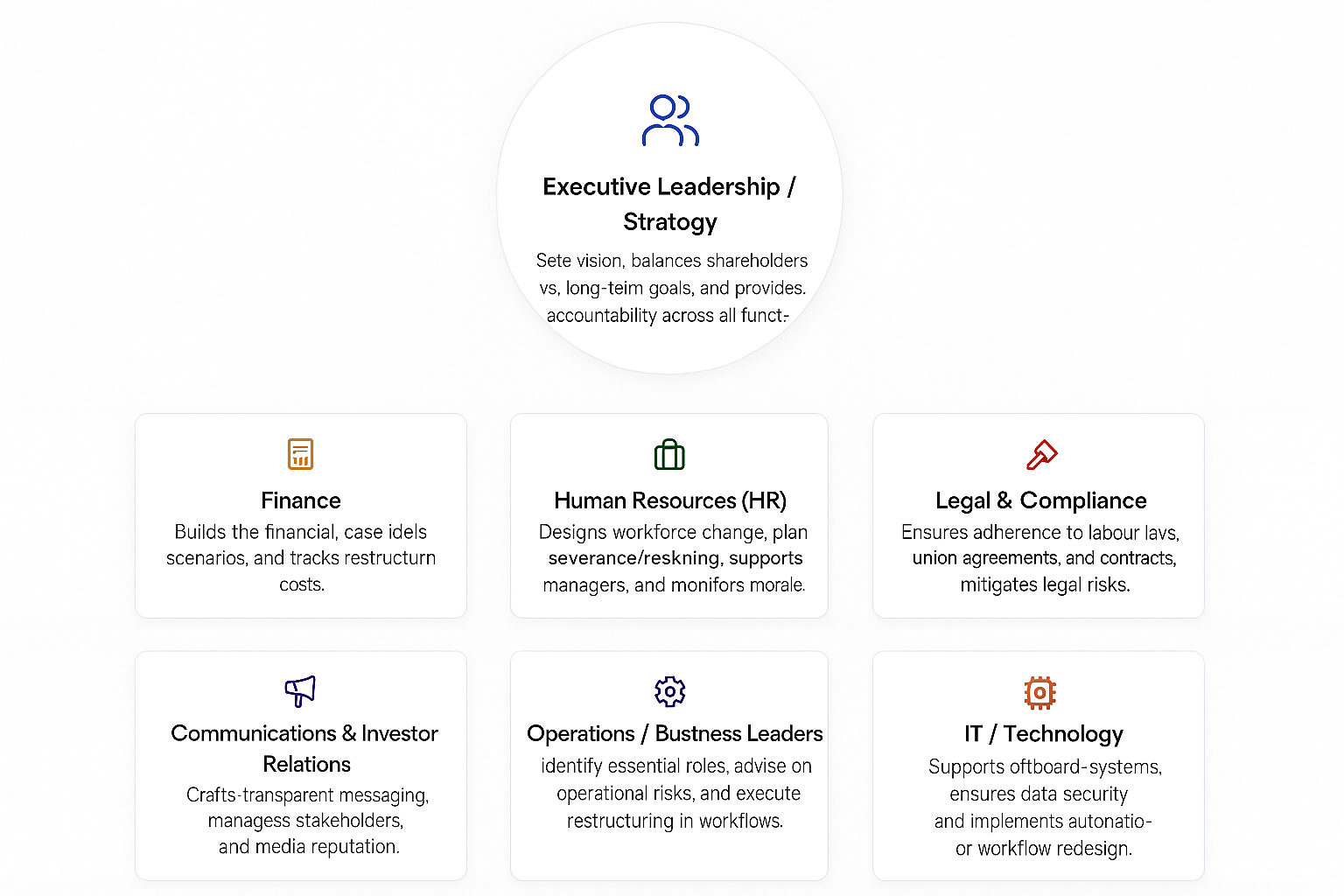
A Strategic Guide to Organization Restructuring, Part 1
Author: Ada Tai, MBA, CPHR, SHRM-SCP
I’ve been watching the pace of corporate restructuring accelerate this year, and it’s striking how no sector seems immune. ConocoPhillips is reducing its global workforce by a quarter. Intel is preparing to slash 24,000 jobs in one of the largest shake-ups in its history. Salesforce is eliminating 4,000 positions as it doubles down on its AI strategy. Paramount Skydance, fresh off its blockbuster merger, is shedding up to 3,000 roles; while Hudson’s Bay, a retailer that’s been part of Canada’s identity for more than 350 years, is closing its doors and letting go of more than 8,300 employees. Add to that layoffs at Starbucks, Amazon, PwC, Burberry and even Recruit Holdings, the parent company of Indeed and Glassdoor1, and the picture becomes clear: we’re in the middle of a global restructuring storm, where technology, cost pressures, and shifting markets are re-writing the rules of work.
In my recent conversations with business leaders, one theme keeps surfacing: many are contemplating a restructuring of their own. However, they’re not just looking to cut costs; they’re seeking a clear strategy. That’s what this guide is about: how to prepare for restructuring with purpose, clarity, and humanity.
Step One: Define the "Why"
Restructuring is one of the most complex decisions a company can make. Done poorly, it can destabilize operations and damage culture. Done well, it can reset the business for future success. The starting point is always the “why.” What problems are you solving?
Common drivers include:
- Financial distress - Reducing costs and/or improving profit margin to stabilize the business
- Market changes - Pivoting toward new products, services, or geographical territories
- Technology shifts - Re-organizing to adopt AI, automation, or other innovations
- Efficiency and competitiveness: Streamline structures or flatten hierarchies
The objectives must be specific, measurable, and aligned with the company's long-term vision. This "why" is the foundation for the entire plan and is essential for communicating with stakeholders.
Step Two: Define the “What”
Once the purpose is clear, organizations can proceed to define the scope. Which functions are absolutely critical to preserve? And which areas could be restructured, consolidated, or phased out?
This stage is about mapping priorities. In my work with clients, I often find that once they clarify their non-negotiables, the rest of the plan comes into focus much more easily.
Step Three: Plan the “How”
Too often, companies jump straight to layoffs, but effective restructuring requires scenario planning. Before jumping to layoffs, I’d advise businesses test different options to see which will lead to the best results for their company. This might include a hiring or salary freeze, reduced hours, offering voluntary exits, retraining employees, or re-deploying talent to new roles. Each option carries different financial, operational, and cultural impacts. Running these scenarios before making cuts prevents costly missteps.
Equally important: restructuring can’t be run by a single department in isolation. Organizations need a cross-functional team of leaders, supported where needed by external advisors who bring objectivity and specialized expertise.

Step Four: Don’t forget about the impact on people
Restructuring doesn't end after the final announcement. In fact, what happens next often determines long-term success.
- For departing employees: Outplacement support protects your brand and helps those affected move forward.
- For remaining employees: Survivor's guilt, anxiety, and low morale are real risks. Leaders need to clarify roles, rebuild trust, and provide a compelling vision for the future.
- For managers: Equip them with training on how to lead through uncertainty and engage in difficult, yet empathetic, conversations.
Restructuring is not just a financial event; it’s an emotional one as well. I explored this in depth in my recent blog, “Layoffs Are Inevitable, Abandoning People Isn’t”, where I shared strategies for minimizing the impact on employees and maintaining trust through change. Organizations that recognize this recover faster and retain stronger teams.
Final Thoughts
Restructuring is never just a financial exercise, it’s about re-designing the future of your business. The choices you make from clarifying the “why” to supporting your people will shape not just your balance sheet, but your culture and competitiveness for years to come. This blog has focused on the critical steps to prepare for a restructuring. In my next post, I will discuss the crucial steps in the execution phase. Stay tuned!
If your organization is considering restructuring, now is the time to prepare. Our team collaborates closely with leaders to bring structure, objectivity, and empathy to the process. Let’s talk about how we can help you navigate change with confidence.
Reference:
1Intellizence. (2025). Major companies that announced mass layoffs. https://intellizence.com/insights/layoff-downsizing/major-companies-that-announced-mass-layoffs/
I see. I hear. I experience. is a column created by and written by Ada Tai, a chartered member of CPHR Alberta. The column is written in a blog format where Ada and invited co-authors will present their own experiences and interpretations of the world of human resources and its impact on business management. This and the subsequent posts are copyrighted materials by the author(s) and only reflect their personal views, not CPHR Alberta’s.
Author bio: With an MBA Degree, a CPHR, and an SHRM-SCP designation, Ada Tai has been working as an HR professional in a variety of industries for close to 20 years. Through her consulting firm, Ada and the team provide a variety of management consulting services. Ada’s public speaking skills have enabled her to be regularly invited to speak about HR, people management, and career-related topics throughout the province. She is also a well-respected Instructor at local universities.
Contact information:
● Website: https://www.badab101.com/
● Blogs: https://www.badab101.com/blog
● LinkedIn: adatai or BadaB-Consulting-Inc
● Facebook: @badabconsulting
● YouTube: BadaB Consulting Inc.
BadaB Consulting Inc. has been a trusted partner in HR and business transformation since 2011. We provide practical, people-first solutions in strategic HR planning, organizational audits, restructuring, mergers & acquisitions, training, recruitment, policy development, outplacement, and beyond.
Our team also helps organizations prepare for the future with technology strategies that align infrastructure, talent, and long-term goals.
The views and opinions expressed in this blog post belong solely to the original author(s) and do not necessarily represent the views and opinions of CPHR Alberta.





